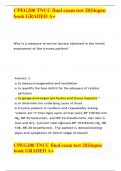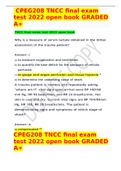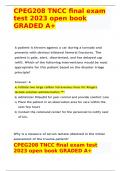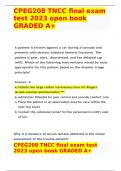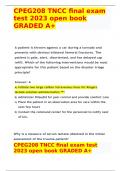Cpeg208 tncc final exam - Study guides, Class notes & Summaries
Looking for the best study guides, study notes and summaries about Cpeg208 tncc final exam? On this page you'll find 25 study documents about Cpeg208 tncc final exam.
Page 2 out of 25 results
Sort by
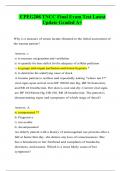
-
CPEG208 TNCC Final Exam Test Latest Update Graded A+
- Exam (elaborations) • 29 pages • 2023
-
- $8.49
- + learn more
Why is a measure of serum lactate obtained in the initial assessment of the trauma patient? Answer: c a) to measure oxygenation and ventilation b) to quantify the base deficit for the adequacy of cellular perfusion c) to gauge end-organ perfusion and tissue hypoxia * d) to determine the underlying cause of shock A trauma patient is restless and repeatedly asking "where am I?" vital signs upon arrival were BP 100/60 mm Hg, HR 96 beats/min, and RR 24 breaths/min. Her skin is cool and dry...
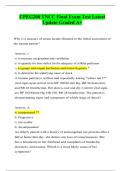
-
CPEG208 TNCC Final Exam Test Latest Update Graded A+
- Exam (elaborations) • 29 pages • 2023
-
- $7.99
- + learn more
Why is a measure of serum lactate obtained in the initial assessment of the trauma patient? Answer: c a) to measure oxygenation and ventilation b) to quantify the base deficit for the adequacy of cellular perfusion c) to gauge end-organ perfusion and tissue hypoxia * d) to determine the underlying cause of shock A trauma patient is restless and repeatedly asking "where am I?" vital signs upon arrival were BP 100/60 mm Hg, HR 96 beats/min, and RR 24 breaths/min. Her skin is cool and dry...

-
CPEG208 TNCC Final Exam Test 2023 Open Book Graded A+
- Exam (elaborations) • 25 pages • 2023
-
- $7.99
- + learn more
Why is a measure of serum lactate obtained in the initial assessment of the trauma patient? Answer: c to measure oxygenation and ventilation to quantify the base deficit for the adequacy of cellular perfusion to gauge end-organ perfusion and tissue hypoxia * to determine the underlying cause of shock A trauma patient is restless and repeatedly asking "where am I?" vital signs upon arrival were BP 100/60 mm Hg, HR 96 beats/min, and RR 24 breaths/min. Her skin is cool and dry. Current vita...
CPEG208 TNCC final exam test 2024open book complete guide GRADED A
CPEG208 TNCC final exam test 2022 open book GRADED A+
CPEG208 TNCC final exam test 2023 open book GRADED A+
CPEG208 TNCC final exam test 2023 open book GRADED A+
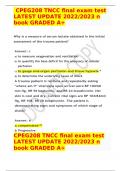
-
CPEG208 TNCC final exam test LATEST UPDATE 2022/2023 n book GRADED A+
- Exam (elaborations) • 33 pages • 2023
-
- $18.99
- + learn more
Why is a measure of serum lactate obtained in the initial assessment of the trauma patient? Answer: c a) to measure oxygenation and ventilation b) to quantify the base deficit for the adequacy of cellular perfusion c) to gauge end-organ perfusion and tissue hypoxia * d) to determine the underlying cause of shock A trauma patient is restless and repeatedly asking "where am I?" vital signs upon arrival were BP 100/60 mm Hg, HR 96 beats/min, and RR 24 breaths/min. Her skin is cool and dry...
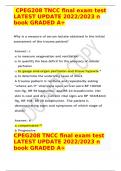
-
CPEG208 TNCC final exam test LATEST UPDATE 2022/2023 n book GRADED A+
- Exam (elaborations) • 33 pages • 2023
-
- $16.49
- + learn more
Why is a measure of serum lactate obtained in the initial assessment of the trauma patient? Answer: c a) to measure oxygenation and ventilation b) to quantify the base deficit for the adequacy of cellular perfusion c) to gauge end-organ perfusion and tissue hypoxia * d) to determine the underlying cause of shock A trauma patient is restless and repeatedly asking "where am I?" vital signs upon arrival were BP 100/60 mm Hg, HR 96 beats/min, and RR 24 breaths/min. Her skin is cool and dry...
CPEG208 TNCC final exam test 2023 open book GRADED A+

Do you wonder why so many students wear nice clothes, have money to spare and enjoy tons of free time? Well, they sell on Stuvia! Imagine your study notes being downloaded a dozen times for $15 each. Every. Single. Day. Discover all about earning on Stuvia

